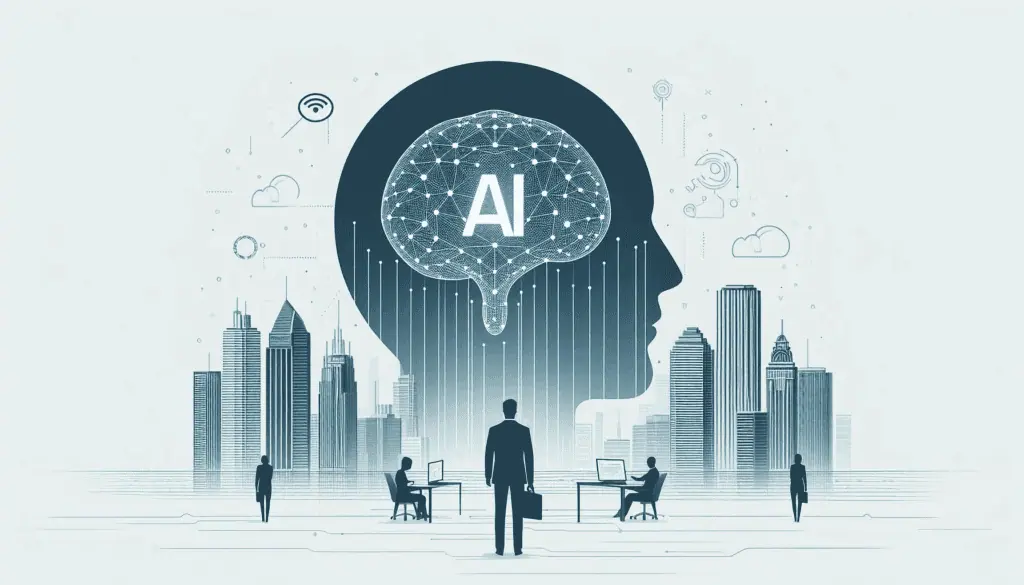AI Transformation: Revolutionizing Industries

Written By:
Last Updated Date:
TL;DR
AI transformation empowers businesses to enhance their operations and stay competitive. The Amazon story illustrates the potential and challenges of AI implementation. Balancing personalization and user privacy is critical.
Data security, infrastructure upgrades, and cost management are vital. Starting small, iterating, and focusing on user empathy ensures successful AI adoption. AI revolutionizes industries, and businesses should outline a clear strategy to leverage its power for growth and improved customer experiences.
Key Takeaways
- Balance Personalization with Privacy: While hyper-personalized recommendations can boost sales, they can also creep customers out. Striking a balance between relevant suggestions and respecting user privacy.
- Data, Security, and Cost: Implementing complex AI systems requires significant investments in data processing, security measures, and infrastructure upgrades. These costs need to be weighed against the potential benefits.
- Start Small, Iterate, and Learn: Don’t go all in on a radical new AI solution. Pilot test on a smaller scale, gather user feedback and adapt the system based on real-world results. Failure is a learning opportunity in the world of AI.
- Innovation Requires User Empathy: Cutting-edge technology is useless if it alienates customers. Understanding user needs and concerns should guide AI development, ensuring a positive user experience.
AI Transformation at Amazon: Balancing Innovation with Customer Comfort
Sarah, a bright-eyed data scientist at Amazon, bounced into her manager David’s office. David, we cracked it! The new recommendation algorithm is a game-changer. It analyzes customer behavior more deeply, factoring in purchase history, browsing patterns, and even social media whispers about the latest trends.
David, a seasoned manager who’d seen his fair share of AI hype, leaned back in his chair, intrigued. That sounds impressive, Sarah. But remember the Bezos mantra: If it’s not suitable for the customer, it’s not good for a company like Amazon.
Sarah nodded, her enthusiasm undimmed. Exactly! This personalizes recommendations like never before. Imagine, instead of just suggesting dish soap because you bought laundry detergent. We’ll recommend that specific brand of organic lavender soap you mentioned wanting on a Pinterest board!
David’s eyebrows shot up. Pinterest boards? That’s a bold move. But if it works. He tapped his pen, considering the costs. Processing all that extra data will require severe upgrades to our server farms. Not to mention the security concerns.
Sarah had anticipated this. We’ve been working with the IT team. The upgrade cost is significant, but the projected sales boost from hyper-personalized recommendations outweighs it in the long run. Security is a top priority. We’ve got a multi-layered approach to ensure customer data remains ironclad.
David wasn’t entirely convinced yet. There’s also the user experience. Hitting customers with overly specific recommendations can feel creepy, like we’re reading their minds.
Sarah grinned. We’ve A/B tested different levels of personalization. Customers respond better to relevant suggestions, which makes it seem like Amazon gets them.
Amazon’s Journey to Hyper-Personalized Recommendations
David sighed. Innovation was exciting, but it came with growing pains. He finally relented. Alright, Sarah. Let’s pilot this on a smaller product category first. Home and garden seems like a good fit.
The pilot launch was a rollercoaster. Sales for gardening tools spiked but then came the complaints. Customers felt bombarded with eerily specific suggestions for trowels and fertilizer based on obscure blog posts they’d read months ago. Negative reviews poured in.
Sarah and her team scrambled. They tweaked the algorithm, dialing back the level of detail and focusing on broader product categories with more generic recommendations. Slowly, the complaints subsided. Sales remained healthy, but the meteoric rise they’d envisioned hadn’t materialized.
David met with Sarah, a touch of disappointment in his eyes. So, the hyper-personalization dream isn’t quite ready for prime time, huh?
Sarah, ever the optimist, took a deep breath. Not yet, David. But we learned a valuable lesson. Customers appreciate a curated experience, but there’s a fine line between personalization and intrusion. We need to find the sweet spot.
David smiled. That’s the spirit, Sarah. We’ll keep refining and pushing the boundaries. After all this success, Amazon stays ahead of the curve, even if the ride gets bumpy sometimes.

News of the pilot program spread like wildfire within Amazon. Although The Recommendation Rollercoaster became a cautionary tale, it reminds us that innovation and user empathy paved the road to AI adoption. Sarah, the enthusiastic data scientist, became known as someone who dared to dream big, even if reality required a few adjustments.
What is Business Transformation?

Empowering Business Transformation in a Competitive Landscape
Organizations must adapt to stay competitive in today’s fast-paced and ever-changing business landscape. This is where the concept of business transformation comes into play.
Business transformation involves re-evaluating and redesigning an organization’s processes, culture, and customer experience to meet changing market demands and stay ahead of the competition. With the power of AI transformation, businesses can now leverage data-driven insights to make informed decisions, automate processes, and create a more agile and efficient organization.
By embracing AI transformation, businesses can future-proof their operations, drive innovation, accelerate, scale, and deliver exceptional customer experiences. This article will delve into business transformation, exploring strategies, benefits, and real-world examples of successful enterprise AI-driven transformations.
Organizations must adapt to stay competitive in today’s fast-paced and ever-changing business landscape. This is where the concept of business transformation comes into play.
Business transformation involves re-evaluating and redesigning an organization’s processes, culture, and customer experience to meet changing market demands and stay ahead of the competition. With the power of AI transformation, businesses can now leverage data-driven insights to make informed decisions, automate processes, and create a more agile and efficient organization.
By embracing AI transformation, businesses can future-proof their operations, drive innovation, accelerate, scale, and deliver exceptional customer experiences. This article will delve into business transformation, exploring strategies, benefits, and real-world examples of successful enterprise AI-driven transformations.
What is AI Transformation?

Revolutionizing Business Operations and Competition
AI transformation is revolutionizing how businesses operate and compete in the digital age. It involves leveraging artificial intelligence to transform an organization’s processes, culture, and strategic direction. AI transformation enables businesses to harness the power of data, automate tasks, and make more informed decisions.
When you apply AI transformation, organizations can drive innovation, improve efficiency, and create new sources of value. This involves implementing AI technologies and rethinking business models, processes, and strategies, enabling you to capitalize on AI’s potential fully.
Why do we Need AI in Business?

Enhancing Business Value and Strategic Focus
AI can learn and adapt, making it a valuable tool for businesses. It can also collect and analyze large amounts of data, which can be used to identify trends and patterns. AI automates repetitive tasks, allowing human employees to focus on more strategic work.
Data analysis can also improve decision-making by providing insights and recommendations. It helps company executives personalize customer experiences and provide better customer service.
AI can potentially improve performance and business impact at organizational and process levels. AI-based transformation projects can create significant business value for organizations.
Organizations should view AI as a configurable IT tool, not a single technology. Successful AI implementation requires strategic reconfiguration of processes to leverage AI’s capabilities.
The rise of AI in business

AI Transformation: Unleashing the Potential of AI Technologies in Business
AI encompasses a range of technologies that enable machines to perceive, reason, learn, and perform tasks autonomously.
Recent advancements in machine learning, deep learning, and natural language processing have propelled AI into the forefront of many industries.
Businesses are leveraging AI to drive the adoption of digital transformation and gain a competitive advantage and advantages.
AI Technologies and Applications:
1- Machine Learning and Deep Learning
Machine learning algorithms enable AI systems to learn from data and make predictions or decisions.
Deep learning, a subset of machine learning, uses multi-layered neural networks to learn hierarchical representations from complex data.
Applications include image and speech recognition, natural language processing, and predictive analytics.
2- Natural Language Processing
Natural language processing (NLP) enables AI systems to understand and interpret human language.
Applications include chatbots, language translation, sentiment analysis, and text analytics, which extract insights from unstructured text data.
3- Robotics and Automation
AI-powered robots and automation are transforming manufacturing, logistics, and service industries.
Industrial robots, autonomous vehicles, and process automation are applications that companies are exploring to increase efficiency and reduce costs.
AI Impact on Industries:
1- Healthcare
- AI revolutionizes healthcare with accurate diagnostics, personalized medicine, drug discovery, and improved patient care.
- Applications include medical imaging analysis, virtual health assistants, and precision medicine.
2- Finance and Banking
- AI is used for fraud detection, investment strategies, credit scoring, and personalized financial advice.
- Chatbots and virtual assistants enhance customer service, while predictive analytics improve risk management.
3- Retail and E-commerce
- AI-driven recommendations, personalized marketing, and customer analytics improve the shopping experience.
- Computer vision and image recognition enable visual search and product recommendations.
4- Manufacturing
- AI-powered robotics, predictive maintenance, and process optimization enhance productivity and efficiency.
- Smart factories leverage AI for flexible manufacturing and mass customization.
What Are The Types of AI?

Types of AI that can be used in businesses:
1- Reactive Machines
These are the simplest types of AI. They can respond to essential stimuli but lack memory or learning capabilities.
2- Limited Memory AI
These AI systems can learn from past data to improve performance.
3- Theory of Mind AI
This type of AI, still under development, aims to understand other’s thoughts, emotions, and beliefs.
4- Artificial Narrow Intelligence (ANI)
This is the most common type of AI, capable of performing specific tasks with high levels of accuracy.
5- Artificial General Intelligence (AGI)
This hypothetical type of AI would possess human-level intelligence and capabilities.
6- Artificial Superintelligence (ASI)
This even more hypothetical type of AI would surpass human intelligence in all aspects.
AI Challenges and Considerations

Accuracy and Bias
Ensuring AI algorithm accuracy and reliability is crucial to prevent biased or misleading outputs. Bias can arise from data selection or algorithm design, affecting output integrity and trust.
Ethical Implications
The role of AI in content generation and decision-making raises ethical questions. Potential job displacement, responsibility for AI-generated content’s accuracy, and moral implications require careful navigation.
Human Expertise and Oversight
While AI assists, human expertise remains vital to guide AI applications effectively. Editorial judgment, ethical considerations, and context understanding necessitate human involvement.
Investment and Training
Implementing AI technology requires investment in infrastructure and staff training to develop skills for successful AI integration and management.
Data Privacy
User behavior analysis and the use of personal data for AI training raise privacy concerns. Ensuring informed consent, data protection, and transparency are critical.
Benefits of AI Implementation in Business

Driving Revenue Growth, Cost Reduction, and Job Creation
- Revenue Growth: According to a report by McKinsey, companies that extensively use AI technology can expect revenue increases of 10% to 20%.
- Cost Reduction: AI adoption has the potential to lead to significant cost savings. A study by PwC estimates that AI could contribute up to $15.7 trillion to the global economy by 2030, with $6.6 trillion coming from increased productivity and $9.1 trillion from consumption-side effects.
- Job Creation and Transformation: Contrary to fears of widespread job loss, AI is projected to create more jobs than it displaces. According to Gartner, AI will create 2.3 million jobs by 2022 while eliminating only 1.8 million.
- Enhanced Customer Experience: AI-driven personalization is reshaping customer experiences. A Salesforce study found that 58% of consumers are willing to share personal data in exchange for personalized offers or discounts, highlighting the value of AI-driven customization.
Outline your company’s AI Strategy

Enhancing Efficiency and Integrity
Artificial intelligence (AI) offers a range of tools and techniques that can address various challenges. However, AI should be viewed as a tool developed to assist humans, not replace them.
Ways to Use AI in Business:
- User engagement analytics: AI can analyze user behavior data to understand reader preferences and improve content discovery. This can help publishers tailor their offerings and marketing strategies to better meet user needs.
- Editorial content management: AI can assist editors in plagiarism detection, manuscript formatting, and reviewer recommendations. This can streamline editorial workflow and improve efficiency.
- Fraud detection and copyright protection: AI can identify potential copyright infringement and fraudulent activities, helping maintain integrity.
- Content creation and translation: AI-powered tools can assist with tasks like content summarization, translation, and even some aspects of writing. This can expedite the publishing process.
How to Use AI in Business?

Steps to Apply AI Transformation
- Standardize the understanding of AI: Clearly define AI terminology and its potential applications within the organization to establish a common ground for learning and discussion. Conduct workshops or training sessions to familiarize employees with AI technologies and their use cases.
- Define how AI drives business outcomes: Articulate how AI initiatives will impact various aspects of the business model, including customer value proposition, profit formula, and critical resources. Use data-driven insights to demonstrate the potential return on investment (ROI) associated with AI projects.
- Identify cracks in your digital foundation and address them: Assess the organization’s current digital infrastructure and identify areas that may hinder successful AI implementation, such as data silos, incompatible applications, or rigid organizational structures. Implement strategies to create a standardized digital foundation for data integration, process automation, and overall agility.
- Dedicate resources to identifying AI use cases and conducting pilots: Establish dedicated teams to identify areas where AI can improve processes, products, or customer experiences. Conduct pilot projects to test the feasibility and effectiveness of potential AI solutions before broader implementation.
- Scale MVPs that improve outcomes and begin continuous learning: Prioritize scaling-up AI solutions demonstrating significant value and positive outcomes. Continuously monitor and refine AI models based on real-time data and user feedback to ensure constant improvement.
How Can AI Be Used to Solve Business Problems?

Balancing Benefits and Ethical Considerations
Artificial intelligence (AI) offers a range of tools and techniques that can address various challenges in business.
The integration of artificial intelligence (AI) in content management offers a range of benefits and challenges. AI technologies can automate various tasks, improve efficiency, and enhance the user experience. However, ethical considerations and potential drawbacks must be addressed to ensure successful implementation.
How is AI Changing Small Businesses?

Empowering Small Businesses with Enhanced Planning and Decision-Making
Small businesses often face challenges in planning and decision-making due to limited resources and manual, time-consuming processes. This case study highlights how artificial intelligence (AI) can address these issues. The small business improved its planning accuracy using automatic feature engineering and machine learning.
AI helped identify relevant data features automatically, reducing manual effort and enhancing model performance for predictive analytics. Also, Machine learning models provided accurate forecasts for metrics like revenue and customer churn.
AI solves the problem of manual, labor-intensive processes, offering small businesses cost savings, improved efficiency, and competitiveness. It enables data-driven decision-making, providing valuable insights previously accessible primarily to larger organizations with more extensive resources. AI, in this context, helps small businesses adapt to market changes, have customers make informed choices, and improve their overall operations.
AI Transformation Playbook

Navigating the Journey to Industry Innovation
Artificial intelligence (AI) can potentially transform every industry, just as electricity did 100 years ago.
Tips to apply AI transformation journey:
Step 1: Identify Use Cases
Identify specific use cases where AI can add more value to your organization. Look for areas with large amounts of data, repetitive tasks, or complex decision-making processes.
Step 2: Assess Data Availability
Evaluate the availability and quality of data. AI relies on data, so ensure you have sufficient and relevant data to train and test AI models.
Step 3: Define Metrics and KPIs
Clearly define metrics and key performance indicators (KPIs) to measure the progress and success of AI initiatives. Align these metrics with your organization’s goals and business objectives.
Step 4: Build the Right Team
Assemble a diverse team with the necessary skills, including data scientists, machine learning engineers, and domain experts. Foster a culture of collaboration and continuous learning.
Step 5: Choose the Right AI Technologies
Select AI technologies that align with your use cases and goals. This may include machine learning, natural language processing, or computer vision.
Step 6: Focus on Data Preparation
Emphasize data preparation and preprocessing. Clean, structured data is crucial for practical AI model training. Address data quality issues and handle missing or inconsistent data.
Step 7: Model Training and Testing
Follow best practices for model training and testing. Utilize cross-validation, regularization, and hyperparameter tuning. Ensure model interpretability and explainability to build trust.
Step 8: Deployment and Monitoring
Plan for seamless AI model deployment, considering scalability, integration with existing systems, and security. Continuously monitor model performance and adjust as needed.
Step 9: Ethical and Legal Considerations
Address ethical and legal implications of AI adoption. Ensure privacy, fairness, transparency, and accountability in AI practices. Engage stakeholders and the public to build trust and address concerns.
Step 10: Continuous Improvement
AI is an iterative process. Continuously gather feedback, refine models, and adapt to changing needs and environments. Foster a culture of experimentation and learning.
AI for Business Leaders Executive Program

Empowering Business Leaders through Executive Education
- AI for Business: This broad category encompasses all the applications of AI in a business context. It includes marketing, finance, operations, human resources, and product development. An AI for Business Leaders program would likely cover the fundamentals of AI and how it can improve various aspects of a business.
- AI Transformation refers to integrating AI into all aspects of a business to improve efficiency, decision-making, and overall performance. An AI transformation program would likely focus on developing a strategic plan for AI adoption, building the necessary infrastructure and talent, and managing the change process within the organization.
- Executive Education: This program is designed for senior business leaders who want to gain knowledge and skills in a specific area. An AI for Business Leaders program would be specifically designed for executives who need to understand AI and lead their organizations through an AI transformation journey.
What is The Future of AI In Business?

Shaping the Future of Business with Innovation and Ethics
The future of AI in business is promising, with enhanced productivity and innovation at its core. AI will streamline operations, improve decision-making, and revolutionize customer interactions through personalization. Ethical considerations are vital to ensuring privacy and transparency.
AI technology will continue to shape a dynamic and thriving business landscape, offering competitive advantages and driving growth. Embracing AI will enable businesses to stay agile, efficient, and responsive to market changes, creating a sustainable future.
The enterprise will harness AI’s potential to maximize operational excellence and customer satisfaction.
Conclusion
Artificial intelligence (AI) is revolutionizing businesses, driving them toward digital transformation. Companies that make a transformation journey by adopting AI technologies unlock a treasure trove of benefits.
Business leaders must develop a clear AI strategy that aligns with overall business objectives. This strategy guides the adoption of AI and its seamless integration into existing operations. Effective communication is critical. Leaders must keep internal teams and external stakeholders informed throughout the AI adoption process. Transparency fosters trust in internal and external communications and ensures everyone understands AI’s value.
Executing pilot projects allows companies to test the waters of AI use cases. These projects provide valuable insights and help refine the complete AI deployment strategy before large-scale deployment. Companies can leverage AI to achieve significant advantages by focusing on these critical elements.
AI adoption brings competitive advantages, helping businesses stay agile and efficient. AI maximizes operational excellence and creates sustainable growth.
The future of AI in business is bright. It opens new possibilities and propels us forward.
Frequently Asked Questions (FAQ)
I’m a Data Enthusiast and Content Writer with a passion for helping people improve their lives through data analysis. I’m a self taught programmer and has a strong interest in artificial intelligence and natural language processing. I’m always learning and looking for new ways to use data to solve problems and improve businesses.






